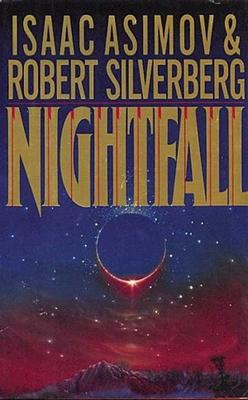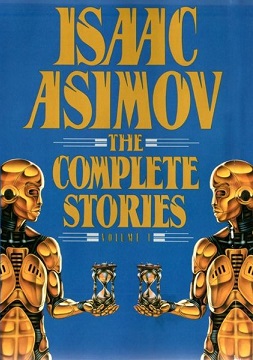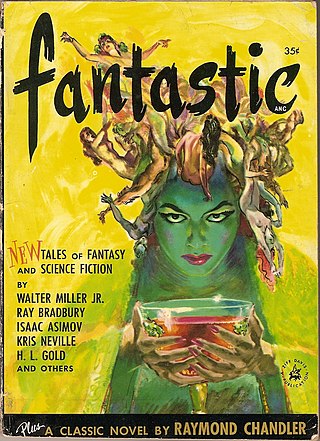Related Research Articles

Isaac Asimov was an American writer and professor of biochemistry at Boston University. During his lifetime, Asimov was considered one of the "Big Three" science fiction writers, along with Robert A. Heinlein and Arthur C. Clarke. A prolific writer, he wrote or edited more than 500 books. He also wrote an estimated 90,000 letters and postcards. Best known for his hard science fiction, Asimov also wrote mysteries and fantasy, as well as popular science and other non-fiction.

The Caves of Steel is a science fiction novel by American writer Isaac Asimov. It is a detective story and illustrates an idea Asimov advocated, that science fiction can be applied to any literary genre, rather than just being a limited genre in itself.
"Robbie" is a science fiction short story by American writer Isaac Asimov. It was the first of Asimov's positronic robot stories. In 2016, "'Robbie" won a retrospective 1941 Hugo Award for best short story. "Robbie" was the fourteenth story written by Asimov, and the ninth to be published. It was the first story in Asimov's Robot series.

"Nightfall" is a 1941 science fiction short story by the American writer Isaac Asimov about the coming of darkness to the people of a planet ordinarily illuminated by sunlight at all times. It was adapted into a novel with Robert Silverberg in 1990. The short story has been included in 48 anthologies and has appeared in six collections of Asimov's stories. In 1968, the Science Fiction Writers of America voted "Nightfall" the best science fiction short story written prior to the 1965 establishment of the Nebula Awards and included it in The Science Fiction Hall of Fame Volume One, 1929–1964.

"Sally" is a science fiction short story by Isaac Asimov. It was first published in the May–June 1953 issue of Fantastic and later appeared in the Asimov collections Nightfall and Other Stories (1969) and The Complete Robot (1982).

The Best of Isaac Asimov is a collection of twelve science fiction short stories by American writer Isaac Asimov, published by Sphere in 1973. It begins with a short introduction giving various details on the stories, such as how they came to be written, or what significance merits their inclusion in a "best of" collection, as well as some of Dr. Asimov's thoughts on a best of collection itself. The stories included are two of his early works, two of his late works (post-1960), and eight from the 1950s, which he refers to as his "golden decade" in the introduction. Except for the last story in the book, "Mirror Image", none of the stories are related to his Robot and Foundation series, while a few mention the Multivac computer.

Nightfall and Other Stories (1969) is a collection of 20 previously published science fiction short stories by Isaac Asimov. Asimov added a brief introduction to each story, explaining some aspect of the story's history and/or how it came to be written.

"C-Chute" is a science fiction short story by American writer Isaac Asimov. It was first published in the October 1951 issue of Galaxy Magazine and later appeared in Asimov's collections Nightfall and Other Stories (1969) and The Best of Isaac Asimov (1973).
The Golden Age of Science Fiction, often identified in the United States as the years 1938–1946, was a period in which a number of foundational works of science fiction literature appeared. In the history of science fiction, the Golden Age follows the "pulp era" of the 1920s and 1930s, and precedes New Wave science fiction of the 1960s and 1970s. The 1950s are, in this scheme, a transitional period. Robert Silverberg, who came of age in the 1950s, saw that decade as the true Golden Age. According to historian Adam Roberts, "the phrase Golden Age valorises a particular sort of writing: 'Hard SF', linear narratives, heroes solving problems or countering threats in a space-opera or technological-adventure idiom."
"Segregationist" is a science fiction short story by American writer Isaac Asimov. The story was written in April 1967 and was first published in December in Abbottempo, a magazine produced by Abbott Laboratories, then later included in the collections Nightfall and Other Stories (1969), The Complete Robot (1982) and Robot Visions (1990).

The Complete Stories is a discontinued series intended to form a definitive collection of Isaac Asimov's short stories and novels. Originally published in 1990 and 1992 by Doubleday, it was discontinued after the second book of the planned series. Altogether 88 of Asimov's 383 published short stories are collected in these two volumes.
"Strikebreaker" is a science fiction short story by American writer Isaac Asimov. It was first published in the January 1957 issue of The Original Science Fiction Stories under the title "Male Strikebreaker" and reprinted in the 1969 collection Nightfall and Other Stories under the original title "Strikebreaker". Asimov has stated the editorial decision to run the story as "Male Strikebreaker" "represents my personal record for stupid title changes".
"Unto the Fourth Generation" is a fantasy short story by Isaac Asimov. It first appeared in the April 1959 issue of The Magazine of Fantasy and Science Fiction (F&SF) and has been reprinted in the collections Nightfall and Other Stories (1969) and The Best Science Fiction of Isaac Asimov (1986). It is Asimov's most explicitly Jewish story.
"In a Good Cause—" is a science fiction short story by American writer Isaac Asimov. The story first appeared in a 1951 edition of the anthology New Tales of Space and Time and was reprinted in the collection Nightfall and Other Stories (1969).

"What Is This Thing Called Love?" is a science fiction short story by American writer Isaac Asimov. The story was requested by Cele Goldsmith Lalli, editor of Amazing Stories, as a satire of an article in Playboy called "Girls of the Slime God" which had suggested that pulp science fiction stories were concerned with aliens and sex. The story appeared in the March 1961 issue of Amazing as "Playboy and the Slime God", but Asimov later retitled it "What Is This Thing Called Love?"

"What If—" is a fantasy short story by American writer Isaac Asimov, first published in the Summer 1952 issue of Fantastic and reprinted in the 1969 collection Nightfall and Other Stories. The story was inspired by the author's wife who, during a car journey they were taking from New York to Boston, asked him where he got his story ideas. Before they arrived, Isaac had thought of a plot based on the journey.
"Breeds There a Man...?" is a science fiction short story by American writer Isaac Asimov. It was first published in the June 1951 issue of Astounding and was reprinted in science fiction anthologies such as Beachheads in Space (1952) and The Great SF Stories #13 (1951), as well as in Asimov-only collections such as Through a Glass, Clearly (1967), Nightfall and Other Stories (1969). and Robot Dreams (1986).
"My Son, the Physicist" is a science fiction short story by American writer Isaac Asimov. It was commissioned by Hoffman Electronics Corporation and appeared in February 1962 in Scientific American. It later appeared in Asimov's collection Nightfall and Other Stories (1969).
"Flies" is a science fiction short story by Isaac Asimov. It was first published in the June 1953 issue of Magazine of Fantasy and Science Fiction, and later appeared in Asimov's collections Nightfall and Other Stories (1969).
Depending on the counting convention used, and including all titles, charts, and edited collections, there may be currently over 500 books in Isaac Asimov's bibliography—as well as his individual short stories, individual essays, and criticism. For his 100th, 200th, and 300th books, Asimov published Opus 100 (1969), Opus 200 (1979), and Opus 300 (1984), celebrating his writing.
References
- ↑ Asimov, Isaac (1969). "Preface to 'It's Such a Beautiful Day'". Nightfall and Other Stories .